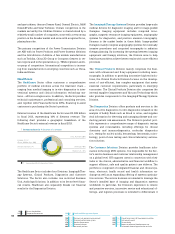Siemens 2013 Annual Report Download - page 159
Download and view the complete annual report
Please find page 159 of the 2013 Siemens annual report below. You can navigate through the pages in the report by either clicking on the pages listed below, or by using the keyword search tool below to find specific information within the annual report.
253 D. Consolidated Financial Statements
357 E. Additional Information
245 C. Compensation Report, Corporate Governance
statement pursuant to Section a of the
German Commercial Code, Takeover-relevant
information and explanatory report
246 C. Siemens AG ( Discussion on basis of
German Commercial Code)
250 C. Notes and forward-looking statements
The Sector’s principal customers are large power utilities, inde-
pendent power producers, and industrial companies, particu-
larly in the oil and gas industry. Because certain significant
areas of the Sector’s business, such as power plant construc-
tion, involve working on medium- to long-term projects for
customers who may not require the Sector’s services again in
the short term, the Sector’s most significant customers tend to
vary significantly from year to year.
The Fossil Power Generation Division competes in all regions
of the global fossil energy markets with demand in Europe and
in the U.S. driven mainly by the need to replace aged existing
inefficient and inflexible power plants, while demand in
emerging countries is driven by capacity additions required as
a result of economic growth.
The Wind Power Division is active in both the onshore and the
offshore market segments around the world, and has main-
tained a leading position in the global offshore market for sev-
eral years. The Division focuses on markets where it can enter-
tain a profitable business, such as the U.S., the U.K. and Scan-
dinavia, although debates over subsidy schemes in these
countries are causing some uncertainty and ultimately are ex-
pected to lead to increased price pressure. Selected emerg-
ing-market countries are increasing their focus on wind energy
as a way to increase resource independence, thus offering a
sound business perspective.
Oil and gas, addressed by our Oil & Gas Division, continue to
play a vital role in the world’s energy supply due to the increas-
ing demand for energy. Oil has very little spare global produc-
tion capacity and, even in a weak global economy, demand still
outstrips supply. On a regional level, growth in the oil and gas
market is mainly driven by the U.S., the Middle East, Russia,
Brazil, and Africa. To keep up with increasing demand and the
depletion of existing reservoirs, the oil and gas industry is go-
ing deeper offshore and exploring unconventional resources
and state-of-the-art enhanced oil and gas recovery techniques
such as subsea processing. In addition, stricter environmental
regulations to reduce waste and emissions are putting pres-
sure on the oil and gas industry to improve energy efficiency,
creating opportunities for a leading solution and technology
provider like Siemens.
The main drivers in the markets addressed by the Power
Transmission Division are expanding infrastructure in emerg-
ing countries, equipment replacement and modernization in
mature economies, and integration of renewable energies.
The most important geographical markets are emerging coun-
tries including Brazil, China, and India, and mature markets
with a significant potential for modernization and new instal-
lation such as the U.S.
The Energy Sector’s business activities vary widely in size,
from selling components and performing comparatively small
projects up to major turnkey contracts, such as for the con-
struction of a new power plant.
While the Sector historically competed primarily with large in-
dustrial companies from industrialized countries, emerging
market competitors have become more and more important,
as they are increasingly expanding their operations beyond
the borders of their home markets. The Sector’s competitors
vary by Division.
The Fossil Power Generation Division’s competition consists of
a relatively small number of equipment manufacturers, some
with very strong positions in their domestic markets, as well as
a large number of engineering, procurement and construction
contractors. Its principal competitors in gas turbines are Alstom,
General Electric and Mitsubishi Heavy Industries, whereas its
main competitors in steam turbines are Alstom, Bharat Heavy
Electricals Limited, General Electric and Toshiba. In China,
manufacturers have historically been mainly focused on their
large home market, but they have begun to evolve from local
to international suppliers. Korean engineering and procure-
ment companies offer a large range of products and solutions,
and position themselves as one-stop-shops that offer custom-
er solutions from a single supplier. In instrumentation and
controls, ABB and Emerson Electric are the Division’s principal
competitors.
The principal competitors in the onshore market served by the
Wind Power Division are Enercon, Gamesa, General Electric,
Goldwind, REpower and Vestas. In the offshore market the
principal competitors are Alstom, Areva and REpower. Further-
more, Vestas and Mitsubishi Heavy Industries have announced
that they are going to combine their individual capabilities to
also enter this market segment. The competitive situation dif-
fers between the market segments. In the market for onshore
wind farms, competition is widely dispersed without any one
company holding a dominant share of the market. In contrast,
there are only a few major players in the market for technolog-
ically more complex offshore wind farms. Overall, the wind
power industry suffers from overcapacity and is widely regard-
ed as being in an early stage of consolidation.
The principal competitors of the Oil & Gas Division vary by
product; in automation and electrical equipment, they are ABB
and Honeywell above all, whereas in compressors and steam
























